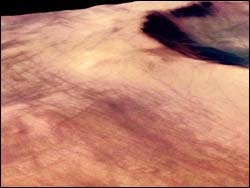This area deals with the fundamental laws and building blocks of nature and how they interact, the properties and the behavior of matter, and research into space and time and their structures.
innovations-report provides in-depth reports and articles on subjects such as astrophysics, laser technologies, nuclear, quantum, particle and solid-state physics, nanotechnologies, planetary research and findings (Mars, Venus) and developments related to the Hubble Telescope.

British astronomers are providing a vital component to the world-wide effort of identifying and monitoring rogue asteroids and comets. From this month, the UK Astrometry and Photometry Programme (UKAPP) for Near-Earth Objects, based at Queens University, Belfast, will track Near-Earth Objects (NEOs) and feed their crucial information into the international programme of protecting the Earth from any future impact by a comet or asteroid.
On average 30-40 NEOs are discovered each

These images, taken by the High Resolution Stereo Camera (HRSC) on board ESA’s Mars Express spacecraft, show a part of the southern highlands of Mars, called Promethei Terra.
The images were taken during orbit 368 in May 2004 with a ground resolution of approximately 14 metres per pixel. The displayed region is centred around longitude 118° East and latitude 42° South.
They show an area in the Promethei Terra region, east of the Hellas Planitia impact basin. The smo

UK radio astronomers at the Jodrell Bank Observatory, working with colleagues from Europe and the USA, have demonstrated a new technique that will revolutionise the way they observe. To create the very best quality images of the sky, they routinely combine data from multiple telescopes from around the world – a technique called Very Long Baseline Interferometry (VLBI). They have now combined this with the power of dedicated internet resources to send data from all the telescopes to a special com

One of sport’s greatest scientific mysteries has been solved, sort of. Two University of Northern British Columbia physicists have explained the centuries-old question of why a curling stone curls, or moves laterally, in a counter-intuitive direction.
The solution – published in the current issue of the Canadian Journal of Physics – isn’t an elegant equation of the kind mathematicians adore, say the scientists, but rather one that involved a lot of experimental sweeping.

Johns Hopkins team examines Kepler’s supernova using NASA’s three Great Observatories
On the night of October 9, 1604, sky watchers – including Johannes Kepler, an astronomer best known for discovering the laws of planetary motion – were startled by the sudden appearance in the western sky of a “new star” which rivaled the brilliance of the nearby planets. Now, exactly 400 years later, a pair of astronomers at The Johns Hopkins University is using NASA’s three Great Observatories to

Physicists at the University of Bonn build quantum data memory
Physicists from the University of Bonn have succeeded in taking a decisive step forward towards processing quantum information with neutral atoms: in the latest issue of the ’Physical Review Letters’ vol. 93 (2004) they describe how they managed to set up a quantum register experimentally. Their next aim is to construct a quantum gate in which two or more atoms interact with each other in a controlled way. By combining th